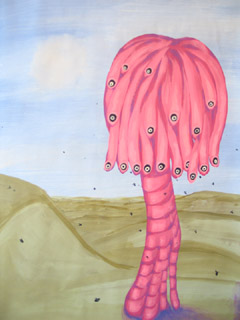
My acquaintance Professor Amberson was traveling recently in the deep Saharan desert along with his family -- when he happened across a Grimberry Tree. This is his how he recounts the experience:
"We're traversing great rolling dunes -- swells like ocean waves in a storm, but made of blistering, dusty sand. We ran out of water a day ago. Our lips are cracked and bleeding. My tongue is a dry, alien thing in my mouth. Death cannot be far away...
But wait! Up ahead there seems to be some sort of tree, bursting from the sand. Surely this must be a mirage, I tell myself -- because the tree is flamboyantly hot pink. But so what if it is a mirage? With nothing to lose, we might as well check it out.
The sweetest smell of honey floats on the air, and the gentle hum of bees fills our ears. It's comical, it's cartoonish: this tree is straight out of a Dr. Seuss story.
And then: the 'happy little tree' lets out a ferocious roar -- like a belching lion.
A pink, slimy frond whips out fast as lightning and grabs my son by the ankle. With demon speed, the tree dashes the boy against the ground repeatedly, swinging him from the ground on the right all the way over its 'head' to the ground on the left and back again. Again and again and again!
The tree sucks Wes -- poor Wes! -- into its canopy, and chews him up with loud crunching sounds. Then: silence. My daughter Polly and I look to each other, stunned.
Just as suddenly, the tree spits out the boy's skeleton like a watermelon seed. Which lands at our feet. Thud."
The Grimberry Tree is a muscular carnivorous plant with slimy pink tentacles in place of leaves. The tree is unable to "walk" per se -- but its root-legs do enable it to stay atop shifting sands and (to an extent) to steer its course as sandstorms reconfigure the landscape around it.
The tree is not sentient -- nor does it even have a "brain," as we understand such things. However, it does have photoreceptors on the ends of many of its tentacles -- which both look and act very much like eyes. These "eyes" interact with its pseudo-nervous system in a way that enables effective attacks on large prey.
For the most part, the Grimberry tree subsists on insects, which are attracted to its distinctly honey-like scent. It also consumes birds when possible -- and as we have seen, equally enjoys human flesh. Typically animal corpses will be dropped from the tree's branches half-digested. The stink of rotting flesh helps to attract more insects. The "bait" doesn't last for long, however. Such debris is soon "washed away" and buried with the shifting sands.
[In case you're curious: Professor Amberson, Polly, and Wes all miraculously survived their encounter unharmed. I may meet up with them "on the road" in the near future. Last I heard, the family was planning an outing to Mount Etna, to take an up-close look at the ongoing volcanic eruptions.]


1 comment:
What a gripping account of such a strange and wondrous creature! My hat's off to you, Professor...
Post a Comment